1-864-859-9314 • 877-712-2017 • Call 24/7
Common Names
Anodizing
Applicable Specs
Federal Specification Mil-A-8625
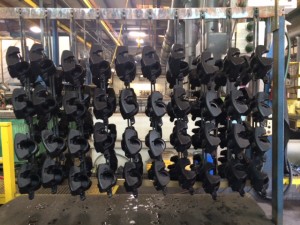
Description
When aluminum (or other “reactive metals”) are made anodic in an aqueous electrolic cell, an oxide coating forms. This electrolytic process, known as anodizing, has resulted in many applications for which un-anodized aluminum would be unacceptable. Increased corrosion resistance, excellent wear and abrasion properties, and a wide range of decorative finishes are but a few of the advantages realized by anodizing.
The nature of the oxide film is controlled by the anodizing electrolyte. If the oxide coating is not soluble in the anodizing electrolyte, it will grow until the resistance of the oxide prevents current from flowing. The coating formed will be extremely hard, non-porous, and non-conductive. At Palmetto Plating Co., Inc., we use the conventional sulfuric process and offer clear as well as dyed finishes. This is commonly known as Type II anodize.
Features & Benefits
The basic reaction in an anodizing process is the conversion of the aluminum surface to aluminum oxide. This aluminum oxide coating can vary from 0.0002” to 0.001” in thickness and is hard, dense, and dielectric. Anodic coatings may be dyed prior to the final sealing operations. For maximum corrosion resistance, the potassium dichromate sealing process should be specified (this produces a slight yellow-green color). Anodizing will increase corrosion resistance, increase paint adhesion, improve decorative appearance, provide electrical insulation, and increase abrasion resistance.
The clear anodize is silver-gray in color, and is dependent upon the specific alloy. There may be a slight dulling of bright surfaces due to the required etch step prior to anodize (wrought or plate material).
Applications
Medical equipment and components, food equipment, automotive trim, electrical equipment, textile machinery, aircraft components.
Considerations & Limitations
Base Material: Aluminum, aluminum alloys. Die casting alloys can be anodized but may have significant differences in appearance and performance of the coating due to the natural porosity and differences in the composition at the surface of the cast material.
Shape of Parts: Can be used on virtually any shaped parts. Sharp edges are not recommended as the integrity of the coating at sharp surface transitions may not be satisfactory.
Size: Parts up to 5½ feet by 28 inches by 17 inches. Maximum weight 500 lbs.
Quantity: Although quantity affects price, quantity is not a limiting factor. Price is determined by how many parts can be process in an hour.
Thickness of Finish: Varies from 0.0002” to 0.001”.
Masking: Can be used to protect critical machined dimensions, but adds significantly to the cost per unit.
Heat treatment: Generally has no effect prior to anodizing.
Method of Processing: Method of Processing: Parts must be racked with a solid electrical contact. If this is a concern, contact points should be specified.
Pre-Treatment: Parts must be clean and free from oil, grease and tape residue. Parts must be “chemically” clean prior to anodizing. Normal processing includes a non-etch cleaner, caustic etch, and de-smut/de-oxidizer. Use of abrasive blasting or mechanical finishing is sometimes used to obtain a particular surface finish. It should be noted that anodizing will amplify the visibility of any minor variations in the surface preparation.
Post Treatment: After anodize, parts may be dyed. After dyeing, or after anodizing, parts are sealed to enhance and protect the surface from absorption of contaminants.
Packaging: Parts are repacked as received. It is often necessary to wrap parts with paper to prevent scratching. This will be done at the customer’s request.
Quality Control
Process solutions are checked and analyzed following an established schedule and monitored using SPC techniques. Thickness testing can be done at the customer’s request. Salt Spray testing for non-standard alloys (e.g. 7075) (and for coating weight) can be done by submitting samples to an outside laboratory. This is done for an extra charge at the customer’s request. We routinely submit samples for Salt Spray for 2024 and 6061 alloys.
Common Names
Blackening, Black Oxide
Applicable Specs
Federal Specification Mil-DTL-13924 and SAE-AMS2485
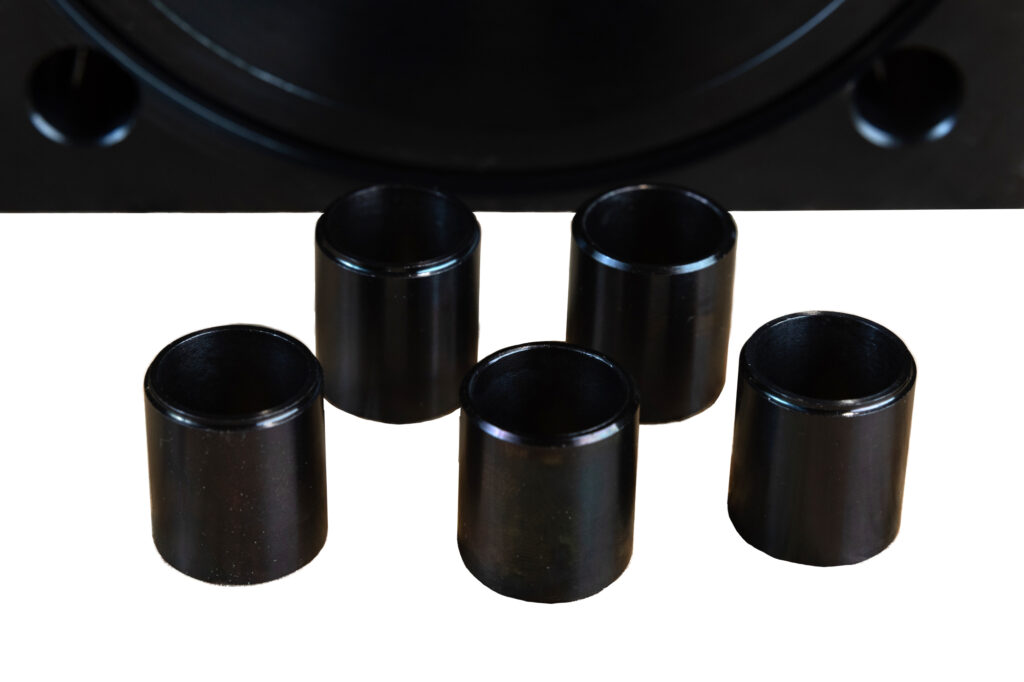
Description
Black Oxide is a process for producing an adherent black finish on steel and iron parts. This film is most often used to provide a uniform black color on steel parts or as a carrier for an oil film which provides limited corrosion protection. At Palmetto Plating Co., Inc., we utilize the so-called “hot process.” This process produces by simple immersion a uniform black coating of ferro-ferric oxide.
Black oxide should be used for indoor use or limited exposure to corrosive conditions.
Features & Benefits
The primary purpose of black oxide coatings is to provide an attractive uniform color to steel or iron parts. The coating has almost no thickness, being only 0.00006” to 0.0001” thick, and is not porous. It withstands severe deformation without flaking. After the black oxide coating is formed, the part is still essentially iron or steel and as such, is subject to further oxidation which will result in red rust. To prevent this, it is necessary to maintain a coating of protective oil.
Applications
Machine tool components, bearing races, hardware.
Considerations & Limitations
Base Material: Steel, Tool Steel, some Iron Alloys.
Shape of Parts: Unlimited except that blind cavities or holes may require a subsequent repeat after repositioning to ensure adequate coverage. Assemblies are not recommended because of the potential for the caustic solution being trapped.
Size: Parts up to 30 inches by 30 inches by 30 inches. Maximum weight 1000 lbs.
Quantity: Although quantity affects price, quantity is not a limiting factor. Price is determined by how many parts can be process in an hour.
Thickness of Finish: N/A
Masking: Can be used to protect critical machined dimensions. Due to the high temperature (~ 285°F) of the process, masking is difficult.
Heat treatment: Generally has no effect although heat treated parts may not develop a deep black color. Some tool steels, including those which have been nitrided, may not accept the coating. Blackening of Stainless Steels is a different process which we do not do.
Method of Processing: Parts must be racked, barrel or basket processed, then they are exposed to a caustic solution at 285°F.
Pre-Treatment: Parts must be free of scale and clean and free from oil, grease and tape residue. Parts must be “chemically” clean prior to processing. Normal processing includes caustic soak, and an acid pickle. Sometimes abrasive blasting or mechanical finishing is required for a more uniform surface finish.
Post Treatment: A protective oil (water displacing is recommended) is required to prevent rusting.
Packaging: Parts are repacked as received. It is often necessary to wrap parts with paper to prevent scratching. This will be done at the customer’s request.
Quality Control
Process solutions are checked and analyzed following an established schedule and monitored using SPC techniques.
Common Names
Bright Dip, Brite Dip, Brightening
Applicable Specs
No known Federal, Military, or Industry Specification
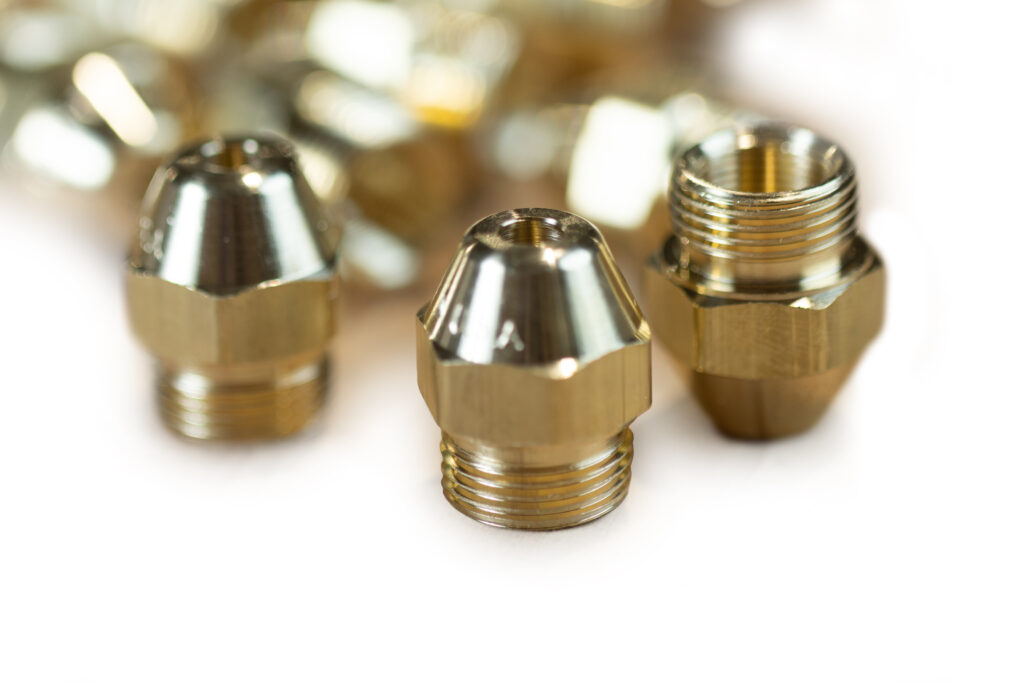
Description
When components made of various alloys are machined it is common to use lubricants to extend tool life and provide a fine machined finish to the parts. Often this lubricant will stain or discolor the brass. If the parts are dry machined, the brass will tarnish from exposure to the normal atmospheric conditions. This is especially true for geographic areas that normally have high humidity. The process of Bright Dip is used to remove the lubricant from the part, remove the stains, and leave a dry to the touch protective coating to prevent staining or discoloration during storage. This final protective coating does not add abrasion properties but certainly provides extended shelf life.
The process is normally processed in stainless steel baskets. We use a proprietary process that has been proven over many years. Our process utilizes an automatic device that transfers the processing baskets with parts through a cleaning process, a chemical polish process, a final protective coating, with rinses between each step. After this process, the parts are dried in a centrifugal dryer and repackaged in the customer’s original packaging.
Features & Benefits
This process is used to clean, remove staining from lubricants or stains resulting from atmospheric exposure, and provide the brass components with extended protection from further staining. There is virtually no dimensional buildup and only a very slight removal of material from machined surfaces.
The process does restore and slightly brightens the brass coloration. The protective final coating will extend shelf life of the product under normal storage conditions but will not provide protection against the brass corroding when exposed to the extremes of weather.
Applications
Small screw machine products made from various alloys of brass, brass forgings, plumbing components, spray nozzles, electrical equipment components.
Considerations & Limitations
Base Material: Copper and Brass alloys including leaded alloys.
Shape of Parts: Can be used on virtually any shaped parts but is especially good on small components.
Size: Normally used for small, machined components
Heat treatment: Brass components are not normally heat treated but Bright Dip will normally remove scale or discoloration because of heat.
Pre-Treatment: Parts must be clean and free of oil, grease, and tape residues. Parts must be “chemically clean prior to Bright Dipping. Normal processing includes a non-etch cleaner.
Post Treatment: After the Bright Dip process, parts receive a water soluble protective coating that is ROHS compliant.
Packaging: Parts are repacked as received. It is often necessary to provide protective packaging to prevent damage from scratching or other damage. This will be done at the customer’s request.
Quality Control
Process solutions are checked and analyzed following an established schedule and monitored using SPC techniques. Additional specific testing may be done at the customer’s request.
Common Names
EN, Electroless Nickel
Applicable Specs
Mil-C-26074; ASTM B-733
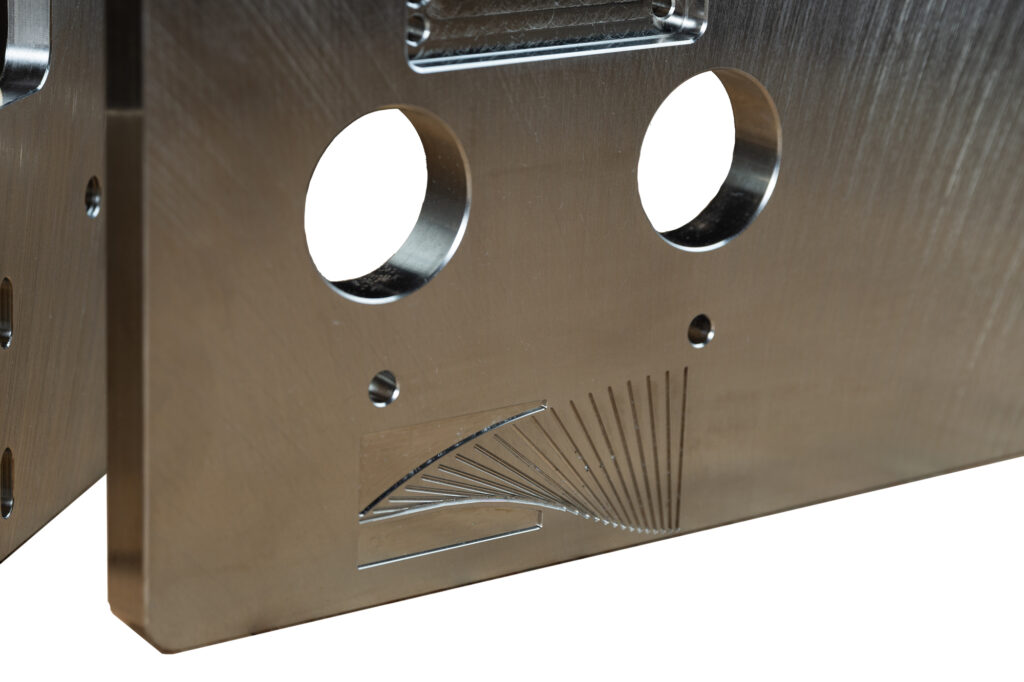
Description
Electroless Nickel refers to the autocatalytic (or chemical) reduction of the aqueous nickel and phosphorous ions onto a base substrate. The process differs from electrolytic plating in that no electrical current is required. The electroless nickel process provides a deposit that follows the contours of the substrate exactly. There is no build-up on edges or corners. A sharp edge receives the same thickness of deposit as a blind hole. There are limitations to this uniformity. The surface must be exposed to a continuous fresh supply of the plating solution. For example, internal cavities in a part may require special pumping of the solution.
Features & Benefits
Electroless nickel is hard, uniform, and corrosion resistant. Typically, in order to provide corrosion protection, the deposit thickness must be greater than 0.0005.” The normal practical upper limit of thickness is 0.002”.
Electroless nickel, because of the presence of Phosphorous in the deposit, is very hard. As deposited, the hardness is about 60 Rc. The deposit has excellent wear resistance, lubricity, and anti-galling properties.
The deposit is a lustrous gray metallic color and may be brush finished to match stainless steel. Deposits greater than 0.0005” are non-porous.
Applications
Food, pharmaceutical, and medical equipment; machine tools, textile machinery parts, packaging machinery parts.
Considerations & Limitations
Base Material: Steel, Tool Steel, Brass, Copper, Aluminum
Shape of Parts: Unlimited except that blind cavities or holes may require supplemental pumping to ensure adequate solution flow. Special fixturing may be required for to control gas pocketing.
Size: Parts up to 30 inches by 30 inches. Maximum weight is 500 lbs.
Quantity: Although quantity affects price, quantity is not a limiting factor. Price is determined by how many parts can be process in an hour.
Thickness of Finish: Varies from 0.0003” to 0.002”. The nominal plating rate is 0.001” per hour.
Masking: Can be used to protect critical machined dimensions.
Heat treatment: Parts which are Rockwell 40c or above must be stress relieved before and after hard chromium plating.
Method of Processing: Parts must be racked or barrel plated. They can be “loose racked” to prevent rack marks.
Pre-Treatment: Parts must be clean and free from oil, grease and tape residue. Parts must be “chemically” clean prior to plating and may require specific activation, chemical etch or activation prior to plating. Parts may require Stress Relief before and after plating. Sometimes abrasive blasting or mechanical finishing is required for better adhesion or to achieve a required surface finish.
Post Treatment: None
Packaging: Parts are repacked as received. It is often necessary to wrap parts with paper to prevent scratching. This will be done at the customer’s request.
Quality Control
Process solutions are checked and analyzed following an established schedule and monitored using SPC techniques. Thickness testing can be done at the customer’s request. Salt Spray testing can be done by submitting samples to an outside laboratory. This is done for an extra charge at the customer’s request.
Common Names
Electropolishing, Electrodeburring, Electrobrightening
Applicable Specs
ASTM B-912-02

Description
Electropolishing is an electro-chemical process for brightening, deburring, polishing, and increasing the corrosion resistance of metal parts. Although most electropolishing is done on the 300 series of stainless steels, other metals may also be electropolished.
The electropolishing process is similar to other metal finishing processes in that it utilizes an electrolytic solution to create a surface finish that is both functional and attractive. In this process the parts are made anodic, thus metal is removed. Metal removal is controllable and is usually on the order of 0.0001” to 0.0025”.
Features & Benefits
Since high current density areas are dissolved faster than low current density areas, electropolishing is very effective for deburring sharp edges. Likewise, the dissolving action tends to smooth surfaces, leaving a bright reflective surface. In the case of stainless steels, surface contamination is removed and the large amount of oxygen liberated at the metal’s surface provides an excellent method for passivation. Generally speaking, electropolishing will reduce surface roughness by one-half. Electropolishing also can reveal cracks and fissures in machined casting by exposing the undisturbed metal surfaces. The presence of sulfur in the alloy may also result in “pulls” which will have the appearance of pits.
Applications
Automotive trim; food, pharmaceutical, and medical equipment and components, process piping, process vessels, food equipment, electrical, equipment, textile machinery, aircraft components, industrial equipment, marine equipment.
Considerations & Limitations
Base Material: 300 series Stainless Steel give the best results. Materials with large grain size, non-uniform micro-structure, and non-metallic inclusions do not give satisfactory results.
Shape of Parts: Unlimited except that blind cavities or holes may require supplemental cathodes and fixturing. Non-stainless steel parts must be masked or otherwise protected.
Size: Parts up to 10 feet long and 2 feet wide can be processed in our tanks. Larger parts can be processed using the wand or “in-situ” method. For processing in our tanks, up to 2000 lbs. Our 10 ton crane can be supplemented with commercial heavy lift equipment for processing in our large processing chamber. Systems or equipment larger than can be transported by truck can be electropolished at the customer’s facility by special arrangement.
Quantity: Although quantity affects price, quantity is not a limiting factor. Price is determined by how many parts can be process in an hour.
Thickness of Finish: N/A
Masking: Can be used to protect critical machined dimensions.
Heat treatment: N/A – sometimes electropolishing is used to remove discoloration.
Method of Processing: Parts can be racked, or fixtured. Very high current is involved in the process.
Pre-Treatment: Parts must be reasonably clean. Any residue from protective plastic film or tape must be removed. Normal processing may include caustic soak clean. If heavy weld scale is present, it may be necessary to pickle the parts prior to processing.
Post Treatment: To prevent a phosphate bloom, parts are treated with a 30% by volume solution of nitric acid, followed by thorough rinsing. Parts with lapped joints or incomplete welds may require neutralization prior to final rinse. For maximum cleanliness, a final rinse with de-ionized water may be necessary.
Packaging: Parts are repacked as received. It is often necessary to wrap parts with paper to prevent scratching. This will be done at the customer’s request.
Quality Control
Process solutions are checked and analyzed following an established schedule and monitored using SPC techniques. We are able to provide profilometer readings (of surface roughness) when required.
Common Names
Hard Chrome, Flash Chrome, Industrial Chrome
Applicable Specs
QQ-C-320, Class 2; SAE-AMS 2406 M
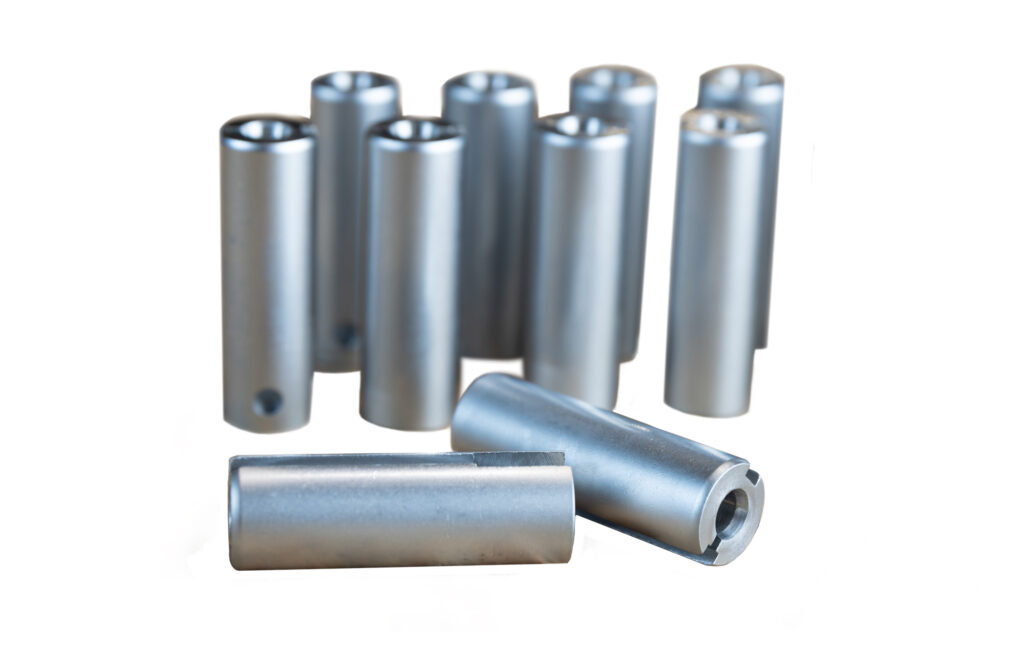
Description
Hard chromium or industrial chromium plating refers to relatively thick chromium deposits applied to a base material because of the hardness, wear resistance, and/or corrosion resistance of the chromium. Hard chromium may be applied to almost any metal. However, each base metal requires specific pre-plating processes. We have limited our process to plating on steel, brass and copper. For these materials, the chromium is deposited directly on the base material. It is common practice to salvage miss-machined parts or parts worn undersize by pre-plate grinding, followed by oversize plating and then grinding to the finished size. Hard chromium is used on original equipment to increase wear resistance.
Features & Benefits
Chromium is extremely hard. Among naturally occurring substances, hard chromium is equal in hardness to aluminum oxide and is second in hardness only to a diamond. As deposited, chromium has a dull luster but is easily polished and buffed to a brilliant highly reflective finish. For thinner deposits, a pre-plate mechanical polish is required if a bright finish is required. For other applications, a pre-plate grit blast may be required. Chromium is extremely corrosion resistant but should never be used in the presence of chlorides. Peeling is seldom a problem with hard chromium. For some special applications where hydrogen embrittlement is a concern, a post plate bake may be required. Thickness of hard chromium may vary from 0.0001” to 0.025”. The true hardness of chromium is achieved from deposits of 0.002” and greater. Hard chromium has excellent lubricity and anti-galling properties.
Applications
Machine tools, textile machinery parts, packaging machinery parts, salvaging of miss-machined and/or worn parts, medical, pharmaceutical, and food applications.
Considerations & Limitations
Base Material: Steel, Stainless Steel, Tool Steel, Brass, Copper
Shape of Parts: Unlimited except that Chromium has extremely poor covering ability (throw). Coverage in internal holes and cavities requires supplemental (auxiliary) cathodes. Special fixturing may be required for complex shapes.
Size: Parts up to 12 feet by 4 feet. Maximum weight is 1000 lbs.
Quantity: Although quantity affects price, quantity is not a limiting factor. Price is determined by how many parts can be process in an hour.
Thickness of Finish: Varies from 0.0001” to 0.025”. The nominal plating rate is 0.001” per hour.
Masking: Can be used to protect critical machined dimensions.
Heat treatment: Parts which are Rockwell 40c or above must be stress relieved before and after hard chromium plating.
Method of Processing: Parts must be racked or fixtured for electrical contact.
Pre-Treatment: Parts must be clean and free from oil, grease and tape residue. Parts must be “chemically” clean prior to plating and may require specific activation or chemical etch prior to plating. Parts may require Stress Relief before and after plating. Sometimes abrasive blasting or mechanical finishing is required for better adhesion or to achieve a required surface finish.
Post Treatment: Light oil may be applied to prevent rusting in deep recesses.
Packaging: Parts are repacked as received. It is often necessary to wrap parts with paper to prevent scratching. This will be done at the customer’s request.
Quality Control
Process solutions are checked and analyzed following an established schedule and monitored using SPC techniques. Thickness testing can be done at the customer’s request. Salt Spray testing can be done by submitting samples to an outside laboratory. This is done for an extra charge at the customer’s request.
Common Names
Bright Nickel, Nickel Plating, Nickel Electroplating, Nickel Plate
Applicable Specs
SAE-AMS QQ-N-290, Federal Specification QQ-N-290

Description
Nickel plating is the electrolytic deposition of a layer of nickel upon a substrate material. The process involves the dissolution of one electrode (the anode) and the deposition of metallic nickel on the other electrode (the cathode). Conductivity between the electrodes is provided by an acidic aqueous solution of nickel salts. Nickel can be used as part of a multi-plate system (such as copper-nickel-chromium or nickel-chromium) or be used as the final finish. Nickel plating is one of the oldest and most widely accepted electroplates.
Features & Benefits
Bright nickel deposits are used primarily to provide decorative finishes on metals that, without suitable protection, will corrode or tarnish. These deposits contain various amounts of sulfur and brighteners and are frequently used as an undercoating for chromium, brass, or precious metal plating.
Applications
Automotive trim; food, pharmaceutical, and medical equipment; house wares; hardware; toys.
Considerations & Limitations
Base Material: Steel, Tool Steel, Brass, Copper, Aluminum, Cast Iron.
Shape of Parts: Unlimited except that blind cavities or holes may require supplemental electrodes to ensure adequate coverage. Special fixturing may be required to control gas pocketing or burning.
Size: Parts up to 7 feet by 2 feet. Maximum weight 500 lbs.
Quantity: Although quantity affects price, quantity is not a limiting factor. Price is determined by how many parts can be process in an hour.
Thickness of Finish: Varies from 0.0002” to 0.002”.
Masking: Can be used to protect critical machined dimensions.
Heat treatment: Generally has no effect but does tend to sometimes affect adhesion.
Method of Processing: Parts must be racked or barrel plated.
Pre-Treatment: Parts must be clean and free from oil, grease and tape residue. Parts must be “chemically” clean prior to plating and may require specific activation, chemical etch or activation prior to plating. Normal processing includes caustic soak, electroclean, and acid pickle. Sometimes abrasive blasting or mechanical finishing is required for better adhesion or to achieve a required surface finish.
Post Treatment: None – a protective clear coat (by others) may be required to prevent tarnishing.
Packaging: Parts are repacked as received. It is often necessary to wrap parts with paper to prevent scratching. This will be done at the customer’s request.
Quality Control
Process solutions are checked and analyzed following an established schedule and monitored using SPC techniques. Thickness testing can be done at the customer’s request. Salt Spray testing can be done by submitting samples to an outside laboratory. This is done for an extra charge at the customer’s request.
Common Names
Passivation, Pickling, Pickel/Passivation
Applicable Specs
Federal Specification QQ-P-35, ASTM A-967, SAE-AMS QQ-P-35, and AMS 2700
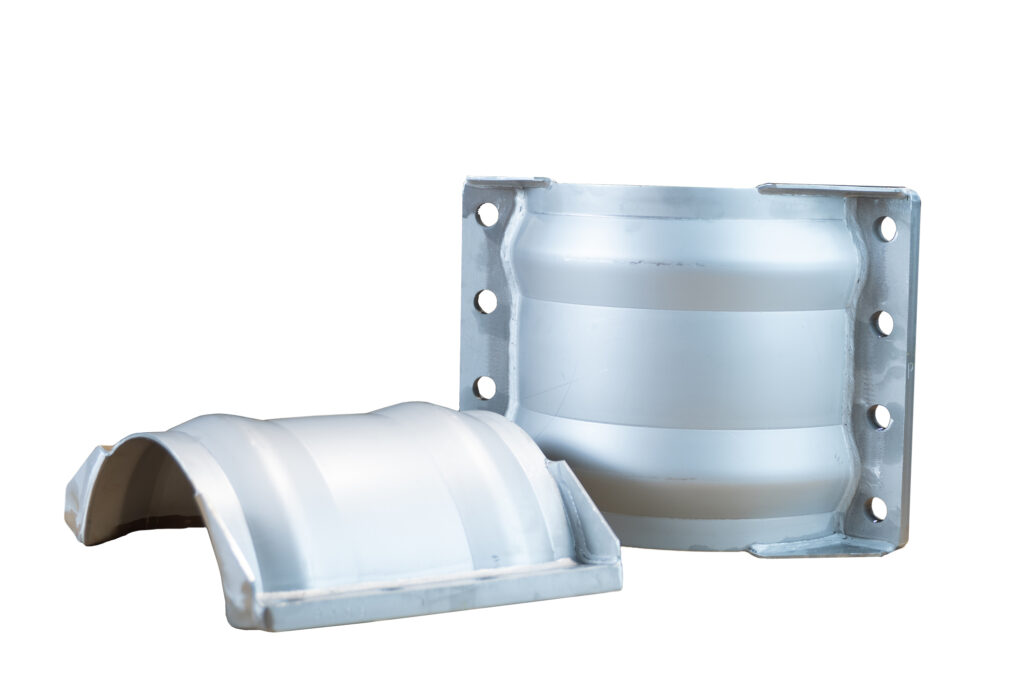
Description
Passivation is the acidic removal of residual iron (or other contaminants) from the surface of stainless steel. Various acids, such as nitric acid, mixed acid, or citric acid are used to accomplish this. Selection of the solution is determined by the specific stainless steel alloy.
Theory says the non-rusting properties of stainless steels are due to a very thin, invisible oxide film that completely covers the surface of the parts and prevents corrosion from taking place. A freshly machined, polished or pickled article will acquire this film rather quickly from contact with the atmosphere. However, such fabricated parts may be contaminated with small particles of foreign matter, which should be removed to impart full stainless properties. An example of this is the slight amount of steel worn off the cutting tools and transferred to the stainless parts during machining. Under certain conditions, a thin coating of rust may appear on the part. This is corrosion of the imbedded tool steel and not the parent metal.
Features & Benefits
The primary purpose of a passivation treatment is to remove surface contamination, usually iron, and to oxidize the alloying constituents so that the optimum corrosion resistance of the stainless steel will be maintained. Passivation is not a scale removal treatment.
Passivation may slightly dull bright parts, leaving a matte gray surface, dependent upon the specific alloy. It may or may not remove heat treat scale.
There are two related processes: Pickling and Pickle/Passivation. Pickling is dipping or otherwise exposing the part to the acid solution to achieve a clean and reactive surface which promotes natural oxidation by the atmosphere. Pickle/Passivation is the same process, except the part is subjected to the solution for an extended period of time to ensure complete removal of residual iron and thorough oxidation of the alloying constituents. We recommend Pickle/Passivation because it has the advantage that it removes not only the surface iron (e.g. from machining or handling) but also any iron actually within the surface of the metal (as a minor alloying ingredient). The extended exposure time also insures full and uniform oxidation of the surface.
Applications
Automotive trim; food, pharmaceutical, and medical equipment; house wares; hardware; industrial equipment; marine equipment.
Considerations & Limitations
Base Material: Stainless Steel.
Shape of Parts: Unlimited except that blind cavities or holes may require supplemental rinsing and/or neutralization to remove the passivation solution.
Size: Unlimited. Maximum weight: Unlimited. Our 10 ton crane can be supplemented with commercial heavy lift equipment. Systems or equipment larger than can be transported by truck can be passivated at the customer’s facility by special arrangement.
Quantity: Although quantity affects price, quantity is not a limiting factor. Price is determined by how many parts can be process in an hour.
Thickness of Finish: N/A
Masking: Can be used to protect critical machined dimensions.
Heat treatment: N/A – some heat treat scale may not be removed.
Method of Processing: Parts can be racked, barrel processed or sprayed.
Pre-Treatment: Parts must be clean and free from oil, grease and tape residue. Degreasing or other cleaning by others may be required for heavily soiled parts. Normal processing may include caustic soak clean. Sometimes abrasive blasting or mechanical finishing is required to remove heavy scale.
Post Treatment: None – a protective covers or caps may be required to prevent contamination during transport.
Packaging: Parts are repacked as received. It is often necessary to wrap parts with paper to prevent scratching. This will be done at the customer’s request.
Quality Control
Process solutions are checked and analyzed following an established schedule and monitored using SPC techniques. Ferroxyl (and similar other methods) testing and certification is available upon request.
Copyright © 2023 Palmetto Plating Inc. • 510 Saco-Lowell Road, Easley, SC 29640 • 864-859-9314
Responsible for our ISO 9001:2015, and AS9100 Quality Management Systems, and Production Support. Crystal is married with 3 children and has been with Palmetto Plating Co., Inc. since 2010.
Responsible of supervision of Decorative Chromium, Electroless Nickel, Anodize, Passivation, and Electropolish Processes. He is also a member of our ISO 9001: 2008 Management Team and a graduate of Clemson University. He is married, and has been with Palmetto Plating Co., Inc. since 2003.
Founded Palmetto Plating in 1964, responsible for the coordination of all marketing, production, quality control, safety, environmental, and administrative activities.
With over 15 years at the company, Staci has played a pivotal role in overseeing laboratory operations, facility operations management, and ensuring compliance with environmental and regulatory standards at both the state and federal levels.
Staci is responsible for all permitting, including RCRA hazardous waste, air permitting, stormwater, and industrial wastewater discharge permits. She is a licensed Physical/Chemical Wastewater Operator (Level B) and holds a Bachelor’s degree in Chemistry from the College of Charleston. Additionally, she is a Certified Electroplater-Finisher (CEF), demonstrating her deep technical expertise in the metal finishing industry.
Before transitioning into metal finishing, Staci spent 15 years in the chemical manufacturing industry, where she held roles as a research analyst and technical director. Her extensive background in chemistry and regulatory compliance has made her a key leader in her field.
Staci is actively involved in industry organizations and currently serves on the Board of Directors for the National Association of Surface Finishers (NASF). She is also the past president of the NASF Palmetto Southeast Chapter, where she has been instrumental in advancing industry standards and professional development.